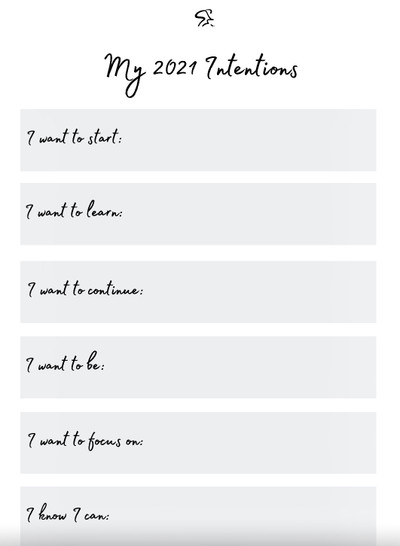
Super Charge Your New Year With This Goal Setting Exercise!
Posted by Spinning® on Jan 14th 2021
We’re two weeks into the new year, so it’s a good time to set the record straight about the difference between a resolution and an intention. The purpose of a resolution is actually to solve a problem (to do or not do something) while an intention is an aim, plan or goal with a little more wiggle-room to get creative on steps toward the solution. Not to say that one is better than the other, however, this year you may wish to mix it up a bit if resolutions have been difficult for you to keep in years’ past.
Below we offer 7 clever steps to set goals for yourself that can bring your best intentions to fruition. You’ll notice there is ample room in the steps to get creative and honor what will work best for you – rather than a clear-cut “pass or fail” like some people feel to be the case with resolutions. We highly encourage you to review the steps below and then use the handy Goal Setting PDF we’ve created just for you. Now charge toward those lofty intentions with concrete goals like the go-getter we know you are!
Step 1: List Your Goals
List four goals you would like to accomplish. At least one goal should be leadership-oriented and involve one other person. At least one goal should also be personal and not necessarily involve your work life. We recommend you keep your timeframe within 3 to 6 months though there may be exceptions. Also, keep your statements specific and brief.
Step 2: Set Priorities
Once you have listed your goals, review them and prioritize them in order of importance. Also make sure the goal has been assigned a completion date that is realistic.
Step 3: Determine Measurable Indicators
Your next step is to determine measurable “success indicators.” How will you know that you have successfully completed your goal? There needs to be something concrete that you can use as an indication of your success. Again, be brief and concise and try to list several “success indicators” for each goal.
Step 4: Indicate Standards of Performance
Because each “success indicator” should be specific and measurable, your next step is to indicate what would be an acceptable level of achievement and what would be an outstanding level. To determine this, it may be helpful to think in terms of the degree of timeliness, quality, quantity and/or cost.
Step 5: Identify Obstacles
Sometimes outside factors beyond your control may affect you achieving your goal. Try to determine what these factors may be and list them if they are relevant.
Step 6: Describe Action Steps
Determine how you will accomplish your goal. There may be several ways to do this so choose the most appropriate one. Then list several action steps (in sequence) to accomplish each goal. Consider whose help or support you will need and build in a step to get that support.
Step 7: Create Incentives
You have just taken the time to plan, prioritize and set standards for the goals you plan to accomplish in the future. It’s important to also take time to recognize what you will gain from achieving your goals and what may be a reward when your goal is accomplished.
Step 8: Don’t Be Afraid to Start Over
It’s possible that you may not accomplish what you set out to do. If this happens, you should go back to goal setting. Reset your goals, timelines and action steps. Start again knowing you have benefited from your experience.
Once you have finished with steps 1-7 for all of your goals, take the time to check them for clarity, feasibility and unanticipated problems.
- Are the timelines realistic? Will competing factors cause a delay?
- Will others agree that your goals are central to your desired outcome?
- Will your goals have an impact? Do they tie into your long-term aspirations?
- How will these goals help you develop new skills?
